Chapter 2
BRIDLES
The bridle is a cord or webbing strap, which is used to
connect the pilot chute to the canopy or deployment
device. Main and reserve bridles, while sharing the same
function, operate differently.
Early bridles were simply a length of suspension line tied
off to the two components. It was soon learned that the
length of the bridle affected the function of the pilot chute
and the opening characteristics of the canopy. If the bridle
is too short, the pilot chute cannot launch properly. If
too long, the snatch force is increased. On most round
emergency and reserve parachute assemblies, the length
and type of the bridle is fixed for optimum performance.
The rigger cannot change the configuration of the bridle
without approval of the manufacturer.
There are two basic types of round canopy bridles. The
first is a tubular nylon bridle that is tied on. The second
is a pre-sewn bridle with loops at each end. The loop of
one end is passed thru the attach point on the pilot chute
and then back thru itself forming a lark’s head knot. The
other loop of the bridle is then similarly attached to the
canopy apex. [Figure 2-31] With this type, it is essential
for the loop to remain loose to ensure the bridle is free
floating and self-centering around the apex lines. Hand
tack the loop to ensure this. [Figure 2-32]
 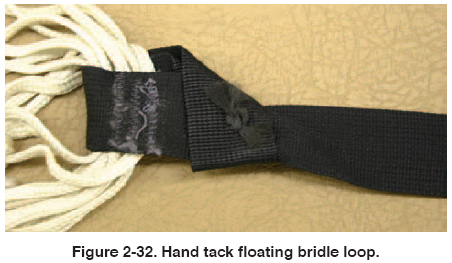
Square reserve bridles are generally built into the free
bag. The bridle material is usually 2" wide or more for
high drag. The original concept of the free bag is to allow
the square reserve to deploy if the reserve pilot chute is
captured resulting in a horseshoe-type malfunction. The high-drag bridle would then pull the reserve bag off the
parachutist’s back and allow the canopy to deploy free
from the bag. In the late 1980s, assistor pockets were
added to the bridles for additional drag as square reserves
became bigger and heavier. [Figure 2-33]
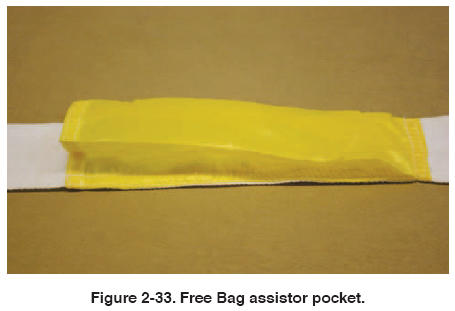
Early main bridles were simply longer versions of the
reserve bridles. This was necessary to compensate for the
“burble” created in free fall by the parachutist. In the mid
1970s and with the advent of the hand deploy pilot chute,
the length of the bridle was critical in order to allow
proper extraction of the locking pin that secured the pack
closed.
In recent years and with the almost total use of ram-air
parachutes, the need for collapsible main pilot chutes has
become widespread. As the main canopies have become
smaller and faster, the drag of the inflated main pilot
chute after opening can have an adverse effect on canopy
performance. This problem has been solved through the
use of a collapsible pilot chute/bridle system. There are
two primary designs used to accomplish this.
The first is the “bungee” collapsible configuration. This
consists of a length of elastic shock cord inside a tape
sheath on the bridle near the pilot chute end. [Figure 2-
34] When relaxed, it holds the apex of the pilot chute collapsed.
When the pilot chute is deployed into the
airstream, the airflow inflates the pilot chute which deploys the canopy. After opening, the elastic pulls the
apex down again and collapses the pilot chute, reducing
the drag. While this system works, its main drawback is
that certain airspeeds are needed to inflate the pilot chute.
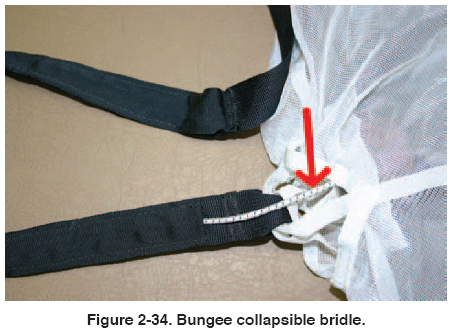
The second type is the “kill-line collapsible” configuration.
This consists of a bridle with a full length channel
through which passes a line of Kevlar® or Spectra®.
[Figure 2-35] The bridle is “cocked” and the lower end of
the bridle is collapsed during packing. This allows the
pilot chute to inflate immediately. During the deployment
sequence, as the canopy inflates, the lower end is
stretched to length and the centerline pulls the apex of
the pilot chute down and collapses it. This configuration
has become almost universal in use for skydiving today.
The only drawback is if the user forgets to cock the bridle
during packing. This will result in a collapsed pilot chute
and a pilot chute in tow. In the early days of use of the
kill-line bridle, this was a problem but has become less
frequent today. A properly made bridle will have a colored
“eye” at the locking pin location to show if it is
cocked and the centerline is set correctly. [Figure 2-36]
 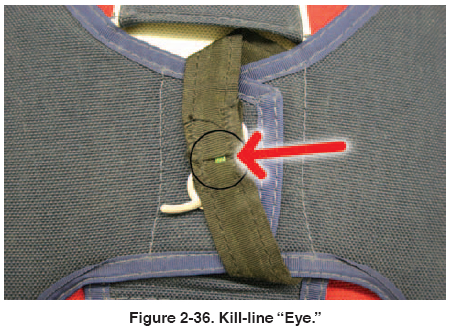
The kill-line configuration is used almost exclusively on
tandem systems due to the high speeds involved and the
size of the drogue pilot chutes. The bridles are usually made from 2" Kevlar® tape and have tubular nylon centerlines.
[Figure 2-37]
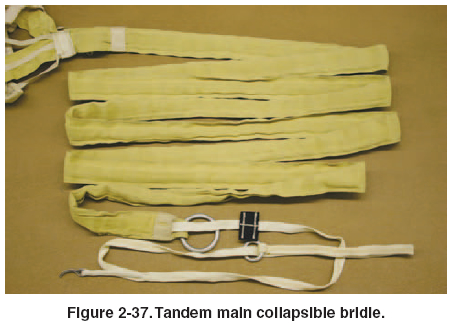
Another method of collapsing the pilot chute is to install
a No. 8 grommet in the deployment bag and allow the bag
to float on the bridle. After the canopy deploys, the bag
slides up the bridle, inverts, and covers the pilot chute.
This is commonly called the “poor man’s collapsible pilot
chute system.” The drawback to this design is the high
wear on the bridle and pilot chute mesh.
| 
